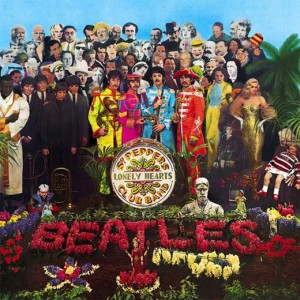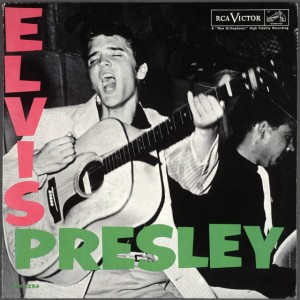Being a passionate music fan, I have had the chance to view a large number of album covers over the course of my life. I will admit that I have even started listening to some artists because their album covers were so intriguing. The importance of visual marketing in a primarily sound-based industry is becoming more and more prevalent. Even looking at my iTunes library sorted by year, I notice different trends from the 1950’s to 2000’s. Early records featured a few key pieces of information directly on the vinyl itself, while the “album cover” was literally just that. This practice largely continued throughout the 1930’s and 40’s with no revolutions in cover marketing. In the 1950’s however, certain artists and record labels began promoting their artists through more appealing covers that would attract the attention of customers in a store. One such record was Elvis Presley’s 1956 self-titled album pictured below. This cover was later replicated by the Clash’s 1979 album London Calling emphasizing the impact it made on the record industry. While nothing extremely special, this record (and others at the time) offered a new way to efficiently market not only the disc itself but the artist. My favorite band, the Beatles, truly changed the way album covers were produced. Their covers range from a blank white canvas to the iconic Sgt. Pepper’s Lonely Hearts Club Band. Even the classic crosswalk photo featured on Abbey Road, which some go so far as to call genius, was a result of The Beatles being “lazy” and simply walking across the street next to their recording studio as noted by Ringo Starr. The point is not that creative individuals place interesting images on their records, but that it has become essential (not to mention purposeful and strategic) in the recording industry. Some albums will feature female singers improperly clothed, or borrow from famous art as Coldplay’s Viva la Vida or Death and All His Friends does with Eugene Delacroix’s Liberty Leading the People, but all have the same goal of increasing “brand” awareness and sales; and since many artists are becoming their own brands, using the term does not seem like a stretch by any means. Another example of the importance of album art is included in the press photos for Apple’s iTunes and iPod. They will generally choose lesser known artists with radical album covers to fit their desired image. Look at the albums in your library, or the next time you go to a music store, and consider the motives behind each album cover and whether or not you believe it influences consumer behavior and purchasing habits – because the disc would sound the same with or without a cover image. I decided to include a few of my favorite album covers below so take a look if you want.
Categories






